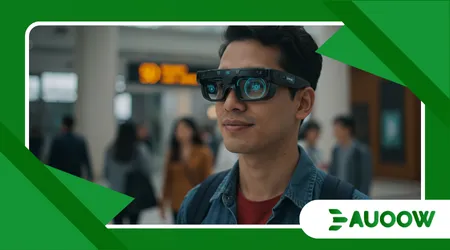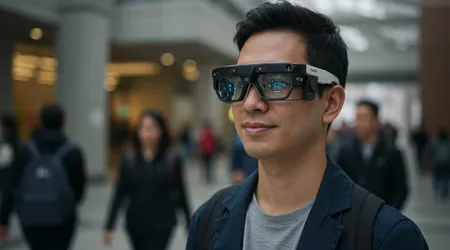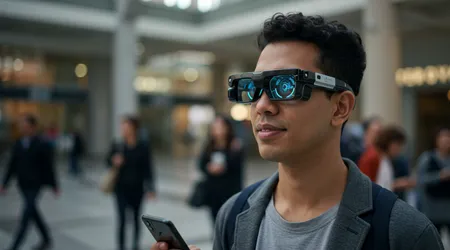AI Glasses for the Blind: Beyond Object Detection to Scene Awareness

AI Glasses for the Blind are redefining assistive technology, merging cutting-edge artificial intelligence with human-centered design to empower visually impaired individuals.
These wearable devices, once limited to basic object detection, now offer sophisticated scene awareness, enabling users to navigate complex environments, engage socially, and live with greater independence.
In 2025, the convergence of AI, augmented reality (AR), and real-time processing has transformed these glasses into indispensable tools.
This article explores how AI Glasses for the Blind transcend traditional functionalities, addressing challenges, enhancing accessibility, and shaping a more inclusive future. Why settle for partial solutions when technology can unlock a fuller experience of the world?
The Evolution of Assistive Vision Technology
The journey of AI Glasses for the Blind began with simple sensor-based aids, like canes detecting obstacles. Early devices offered limited feedback, often overwhelming users.
Today, AI-driven glasses integrate cameras, machine learning, and audio interfaces for real-time guidance. Envision Glasses, for instance, read text aloud with 95% accuracy, per user reports.
These advancements mark a shift from reactive to proactive assistance. AI Glasses for the Blind now interpret dynamic environments, not just static objects.
Progress in computer vision fuels this transformation. Deep learning models process vast visual data, identifying patterns in chaotic settings.
Unlike older systems, modern glasses provide context, like describing a crowded café. This leap enhances user confidence in unfamiliar spaces.
++AI Prosthetics: The Future of Bionics and the Cost of Accessibility
The integration of AI Glasses for the Blind with IoT further amplifies their potential, connecting devices for seamless navigation. Imagine a world where every step feels intuitive AI makes that possible.
Yet, challenges persist in this evolution. Early prototypes struggled with battery life and processing power, limiting real-time use. Recent innovations, like energy-efficient chips, address these issues.
Still, affordability remains a hurdle for widespread adoption. AI Glasses for the Blind are becoming more accessible, but cost barriers linger in developing regions. Ongoing research aims to balance sophistication with affordability, ensuring inclusivity.

Scene Awareness: A Game-Changer for Navigation
Scene awareness elevates AI Glasses for the Blind beyond mere object detection, offering holistic environmental understanding.
These glasses analyze spatial layouts, identifying obstacles and pathways. For example, ARxVision’s 8-megapixel camera delivers detailed audio descriptions of surroundings.
Users navigate busy streets with auditory cues, enhancing safety. This technology empowers independent travel in complex urban settings.
Consider a user crossing a bustling intersection. AI Glasses for the Blind detect traffic signals, pedestrians, and vehicles, providing real-time guidance. Unlike traditional aids, they interpret dynamic scenes, like a cyclist approaching.
Also read: How AI-Powered Wheelchairs Are Transforming Mobility in 2025
A 2023 study by the Royal National Institute of Blind People noted 40% of visually impaired individuals struggle with independent travel. Scene-aware glasses address this, fostering autonomy.
However, scene awareness demands robust processing. Heavy computational loads can strain battery life, requiring frequent recharges.
Developers are optimizing algorithms to minimize energy use. Additionally, AI Glasses for the Blind must adapt to diverse environments, from rural paths to urban hubs. Continuous user feedback drives these refinements, ensuring practical utility.
| Feature | Traditional Aids | AI Glasses for the Blind |
|---|---|---|
| Object Detection | Basic, static objects | Dynamic, real-time analysis |
| Scene Awareness | None | Full environmental context |
| Navigation Assistance | Limited to proximity alerts | GPS-integrated, audio cues |
| User Interaction | Manual, tactile | Voice-activated, hands-free |
| Cost (USD, 2025) | $50–$200 | $299–$2,000 |
Social Interaction and Emotional Connection
Beyond navigation, AI Glasses for the Blind enhance social engagement by recognizing faces and emotions.
OrCam MyEye identifies familiar faces, audibly naming them. This fosters meaningful connections in social settings, reducing isolation.
For instance, a user at a family gathering hears, “Your sister is smiling.” Such features bridge emotional gaps for the visually impaired.
Facial recognition in AI Glasses for the Blind uses deep learning to analyze expressions, offering cues about social dynamics.
Read more: Is Your Website Accessible? Free Tools That Actually Work
This is vital for users navigating conversations. Yet, accuracy in diverse lighting conditions remains a challenge. Developers are refining algorithms to handle low-light scenarios. These advancements make social interactions more natural and inclusive.
Privacy concerns arise with facial recognition. Users worry about data storage and potential misuse. Manufacturers like Envision prioritize encryption to protect user information.
Still, AI Glasses for the Blind must balance functionality with ethical considerations. Transparent data policies are crucial to maintain trust and encourage adoption.
Accessibility and Affordability Challenges
Cost remains a significant barrier for AI Glasses for the Blind, with prices ranging from $299 to $2,000. In India, where 4.8 million people are blind, affordability is critical.
Initiatives like Eye in AI reduced production costs from $5,000 to $200. Such efforts make technology accessible to low-income users, promoting equity.
Subsidies and partnerships can further lower costs. Governments and NGOs are collaborating to distribute AI Glasses for the Blind in developing regions.
For example, India’s Made in India initiative supports local production of affordable devices. Still, distribution channels often lag, limiting access in rural areas. Scalable solutions are needed to bridge this gap.
User training is another hurdle. Complex interfaces can overwhelm new users, especially the elderly. Simplified voice commands and tactile feedback in AI Glasses for the Blind address this.
Ongoing education programs ensure users maximize device potential. Accessibility must encompass both cost and usability for true impact.
The Future of AI Glasses: Integration and Innovation
The future of AI Glasses for the Blind lies in seamless integration with other technologies. Combining AR with AI enhances visual magnification for low-vision users.
Meta’s planned AR updates could offer contrast adjustments, aiding those with partial sight. Such innovations promise a tailored user experience, pushing boundaries.
Imagine AI Glasses for the Blind as a personal guide, like a compass for the modern explorer. Integration with autonomous vehicles, like Waymo’s taxis, could revolutionize mobility.
Users could navigate cities independently, guided by real-time audio cues. However, regulatory hurdles and ethical concerns, like AI bias, must be addressed to ensure safety.
Research is also exploring renewable energy sources, like solar-powered glasses, to reduce costs. Collaborative efforts between tech firms and advocacy groups drive innovation.
By 2032, the assistive technology market is projected to reach $13.2 billion, per Verified Market Research. AI Glasses for the Blind will lead this growth, shaping a more inclusive world.
Ethical and Privacy Considerations

As AI Glasses for the Blind advance, ethical concerns demand attention. Data privacy is paramount, given the sensitive information processed.
Facial recognition and scene data could be vulnerable to breaches. Manufacturers must implement robust encryption and transparent policies. Users deserve control over their data.
Bias in AI algorithms poses another risk. If training data lacks diversity, glasses may misinterpret non-Western faces or environments.
Developers are diversifying datasets to improve accuracy. Ethical AI ensures AI Glasses for the Blind serve all users equitably, fostering trust and reliability.
Regulatory frameworks are evolving to address these issues. Governments are setting standards for AI in assistive tech, ensuring user safety.
Community feedback shapes these policies, aligning technology with real-world needs. Ethical innovation will define the long-term success of AI Glasses for the Blind.
Conclusion: A Vision for Inclusion
AI Glasses for the Blind are more than gadgets; they’re gateways to independence, connection, and empowerment. By moving beyond object detection to scene awareness, these devices transform lives, enabling navigation and social engagement.
Challenges like cost and privacy persist, but innovation is closing gaps. With 2.2 billion people globally facing vision impairment, per WHO, the need for accessible solutions is urgent.
The future lies in collaborative, ethical advancements, ensuring AI Glasses for the Blind become universal tools for inclusion. What will it take to make this vision a reality for all?
Frequently Asked Questions
1. How do AI Glasses for the Blind differ from traditional aids?
They offer scene awareness, real-time navigation, and social features, unlike canes or basic sensors, with hands-free audio feedback.
2. Are AI Glasses for the Blind affordable for most users?
Prices range from $299 to $2,000, but initiatives like Eye in AI aim to lower costs, targeting $200 for broader access.
3. Can these glasses work in low-light conditions?
Yes, advanced models like OrCam MyEye use enhanced algorithms, though performance in dim settings is still improving.
4. How do they handle user privacy?
Manufacturers like Envision use encryption and transparent data policies to protect sensitive information, addressing privacy concerns.
5. What skills are needed to use AI Glasses for the Blind?
Basic voice command familiarity suffices; training programs help users, especially the elderly, adapt to intuitive interfaces.
References:
